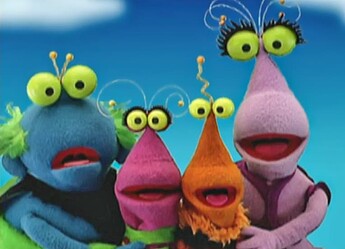…and that opens up a whole other can-o-worms! As in can Kermitus hybridize with Suidae?
*genera
Is the green creature (called Oscar the grouch by locals) related to Troglodytes or Pygmytroglodytes? Honestly, I don’t think it’s either. It has a habit of hiding in items like garbage cans, probably as camouflage and for self defense (like a hermit crab). Seems to be a scavenger, but this is not confirmed. Moreover, unlike genus Pygmytroglodytes (cookie monsters), it’s eyes are not on the top of it’s head. Unlike Troglodytes (elmos), it has no nose. So what is this mysterious creature?
A new genus, Oscarus?
Probably. I would call it ‘seasmicus viridis’. Seasmicus implies the family from which this species is from (including big-birds,troglodytes,etc) and viridis means green in latin. (I’m proud to say I’ve made a good-ish scientific name! Finally! ).
Oscarus-seasmicus viridis.
This one is monotypic, actually. Kermitus hensonii, Henson’s kermit frog.
![]()
![]()
![]() Methinks, given the number shag carpets from the 70s, this animal may have been hunted to near extinction.
Methinks, given the number shag carpets from the 70s, this animal may have been hunted to near extinction.
I think so, but fortunately scientific documentaries on the family Muppetidae, such as Sesame Street and The Muppet Show seem to have brought conservation efforts to the attention of the public. I would like to note that the individuals seen on these shows are ambassador animals who cannot be returned to the wild due to injury or unhealthy habituation to humans. Wild individuals appear much more seclusive.
Very serious and important scientific documentaries.
More information has come out on the rather reclusive family Haribodae.
Haribodae is currently comprised of one genus, Haribo, with one species, Haribo haribo.
Thank you for your correction!
No problem! I love being pedantic :)
Trodoglytes rufus is now Viasesamicus rufus.
Does anyone know which part of North America has the most sightings of V. rufus aka Elmo?
In Washington and Oregon, United States ![]() .
.
Oh wow. @micah-g have you spotted these before?
Yeah, he jumped me when I was birding and I barely escaped. He was hiding behind a bush.
He just wanted a hug. Or possibly a tickle; it’s dificult to be certain.
